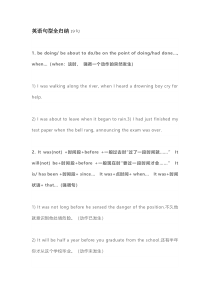 DOC
DOC
【文档说明】高考英语句型全归纳.docx,共(10)页,16.841 KB,由小魏子文库上传
转载请保留链接:https://www.ichengzhen.cn/view-239912.html
以下为本文档部分文字说明:
英语句型全归纳19句1.bedoing/beabouttodo/beonthepointofdoing/haddone…,when…(when:这时,强调一个动作的突然发生)1)Iwaswalkingalong
theriver,whenIheardadrowningboycryforhelp.2)Iwasabouttoleavewhenitbegantorain.3)Ihadjustfinishedmytestpaperwhenthebellrang,announ
cingtheexamwasover.2.Itwas(not)+时间段+before+一般过去时“过了一段时间就……”Itwill(not)be+时间段+before+一般现在时“要过一段时间才会……”Itis/has
been+时间段+since…Itwas+点时间+when…Itwas+时间状语+that…(强调句)1)Itwasnotlongbeforehesensedthedangeroftheposition.不久他就意识到他处境危
险。(动作已发生)2)Itwillbehalfayearbeforeyougraduatefromtheschool.还有半年你才从这个学校毕业。(动作未发生)3)Itis3yearssincehewo
rkedhere.=helefthere.(since从句中的谓语动词若是延续性动词,要从这个动作结束的时候算起)4)Itwas3o’clockwhentheyreceivedthetelephone.5)Itwasat3o’clockthatthe
yreceivedthetelephone.3.once…一旦……,表示时间和条件1)Onceyoustart,youwillnevergiveup.2)Onceyouunderstandwhattheteach
erexplained,youwillhavenodifficultydoingthework.4.the+比较级……,the+比较级……“越……越……”Themorebooksyouread,themoreknowledgeyouwillget
.5.whether…or…无论是……还是……1)Whethertheweatherisgoodorbad,theywillsetoffastheyplanned.2)Anyperson,whetheryo
ungorold,hashisownworth.6.祈使句+or/otherwise+结果句或祈使句+and+结果句1)Stopdoingsuchafoolishthing,oryouwillbepunishedinti
me.2)Moreeffort,andtheproblemwouldhavebeensettled.7.everytime/eachtime/nexttime/thefirsttime/anytime等短语引导时间状语从句,表示“每当,每次,下次,第
一次,任何时候”。1)Everytimeyoumeetwithnewwordswhilereading,don’talwaysrefertoyourdictionary.2)Nexttimeyoucome,doremembertobr
ingyoursonhere.3)Youarewelcometocomebackanytimeyouwantto.8.Thereis(no)needtodo…Thereis(no)hope/chance/possibilityofdoing…Thereis(no)difficult
y/trouble/point/delay(in)doing1)Isthereanychanceofourwinningthematch?2)Thereisnopointindiscussingtheproblem
again.9.it强调句:基本构成形式:Itis/was+被强调部分+who/that+原句剩余部分Imethiminthestreetyesterdayafternoon.ItwasIwho/thatmethiminthestreetyesterdayafternoon.(强调是我,
不是别人)ItwasinthestreetthatImethimyesterdayafternoon.(强调是在大街上,不是在别的地方,强调的是地点,但不用where)ItwasyesterdayafternoonthatImethiminthestreet
.(强调是昨天下午,不是在别的时候,强调的是时间,但不用when)10.not...until直到……才1)Thevillagersdidn’trealizehowseriousthepollutionwasuntilallt
hefishdiedintheriver.2)Itwasnotuntilallthefishdiedintheriverthatthevillagersrealizedhowseriousthepol
lutionwas.(强调句)3)Notuntilallthefishdiedintheriverdidthevillagersrealizehowseriousthepollutionwas.(倒装句)11.notonly…bu
t(also)…引导并列结构:作主语时,谓语动词与邻近的一个主语保持一致。Notonlytheteacherbutalsothestudentshavetheireyesexaminedregularly.noto
nly...but(also)…引导并列句时,notonly引导的部分置于句首时要部分倒装。1)Notonlywaseverythinghehadtakenaway,butalsohisGermancitizenshipwastakenaway.2)Notonlyshouldwestuden
tsstudyhard,butalsoweshouldknowhowtoenjoyourselvesinoursparetime.12.wouldrather+从句(从句要用虚拟语气,即从句中谓语动词用一般过去式,表示现在或将来的愿望;从句中谓语动词用过去完成市,表示对过去的愿望)1)I’dra
theryoupostedtheletterrightnow.我想让你现在就把信寄出去。2)I’dratherIhadn’tseenheryesterday.我情愿昨天没见到她。13.so,neither/nor引导得倒装表示“另一
者也如此”及前者的情况也适用于后者,用so,neither/nor引导的倒装句,助动词的选择依据前一句的谓语动词。1)Hehasfinishedhishomework,sohaveI.2)Mysisterpreferscoffee,sodoI.3)Johncan’tri
deabicycle,neither/norcanI.若前句的谓语动词既有肯定又有否定形式时,或谓语动词不属于一类时,用Itis/wasthesamewithsb.或Soitis/waswithsb.4
)Heisaworkerandheworkshard,soitiswithJohn.若后一句是对前一句所说的内容表示赞同或认可,则主语和谓语不倒装。1)—Itiscoldtoday.—Yes.Soitis2)—HevisitedTokyola
stweek.—Yes.Sohedid.14.倍数表达法:A+谓语+倍数+the+n.(size/height/length…)+ofBA+谓语+倍数+as+abj.+asBA+谓语+倍数+adj.比较级+thanBA+谓语+adj.比较级+thanB+by+倍数1)Thissquare
istwicethesizeofthatone.Thissquareistwiceaslargeasthatone.Thissquareisoncelargerthanthatone.2)Thisfactoryproducedthreetim
esasmanycarsastheydid10yearsago.3)Heis3yearsolderthanIHeisolderthanIby3years.15.as/with表示“随……进展”,as后面接句子,with后面接短语。1)Withtheindustrydeveloping,t
hepollutionisbecomingmoreandmoreserious.2)Astheindustrydevelops,thepollutionisbecomingmoreandmoreserious.16.with的复合结构(作状语或作定语)with+n.+adj.(with可以
省略)1)(With)thestreetwetandslippery,wehadtorideourbikesslowlyandcarefully.Becausethestreetwerewetandslippery,…2)Thestudentswerelisteningtot
heteacher,(with)theireyeswideopen.Thestudentswerelisteningtotheteacher,andtheireyeswerewideopen.with+n.+adv.(with可以省略)1)He
putonhiscoathurriedly,(with)thewrongsideout.with+n.+prep-phrase(with可以省略)1)Theoldmanwasseatedinthesofa,(with)apipeinhismouth.
with+n.+todo/tobedone(动词不定式的动作还未进行)with+n.+doing/beingdone(动词不定式的动作正在进行)with+n.+done(动词不定式的动作已经完成或指n.所处的状态)1)Withsomanypr
oblemstosettle,thenewly-electedpresidentishavingahardyear.2)Hewaslyinginbed,withhiseyesfixedontheceiling.3)Withthetemplebeingre
paired,wecan’tvisitedit.17.以here,there,in,out,up,down,away等副词开头的倒装句(多用一般现在时表示正在进行的动作)。1)Herecomesthe
bus!(=Thebusiscominghere!)2)Awayhewent.他走远了。(若主语是代词则主语与谓语不倒装)18.方位状语位于句首时的倒装句。1)Infrontofthehousestoppedapolicecar.2)Und
erthetreesataboy,withabookinhishand.19.具有否定意义的副词或短语位于句首时句子要部分倒装。常用的有:little,never,seldom,hardly,rarely,nosooner,innotime,bynomeans,inno
case等。
 辽公网安备 21102102000191号
辽公网安备 21102102000191号
 营业执照
营业执照